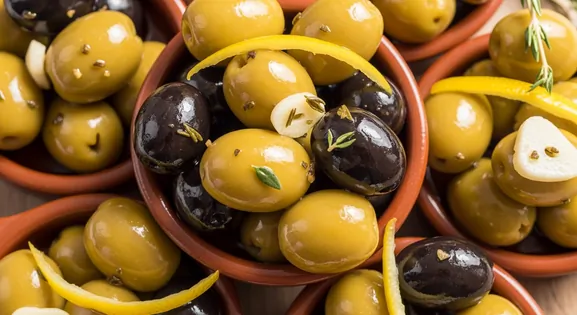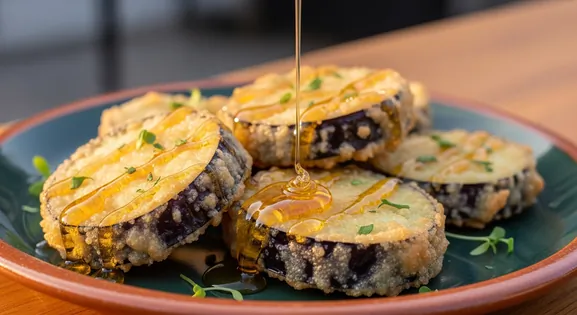Cazón en Adobo (Marinated Dogfish) in Seville
Cazón en Adobo

Cazón en Adobo (Marinated Dogfish): A Local Culinary Staple
Stepping into a bustling Sevillian tapas bar, the aroma of freshly fried cazón en adobo is irresistible. This marinated dogfish, a local favorite, offers a delightful crunch and tangy flavor. It’s the perfect bite to accompany a cold beer, embodying the vibrant culinary spirit of Seville.
New to Cazón en Adobo (Marinated Dogfish)? Learn all about its history in our complete guide.
Local Significance
Local Significance
In Seville, cazón en adobo represents the city's connection to the sea despite being inland, showcasing how river trade brought coastal traditions upriver. It's a fundamental part of Sevillian tapas culture.
Eating Customs
- In Seville, it's common to eat standing at the bar rather than sitting at a table, especially in traditional establishments.
- Sevillanos typically squeeze lemon over the cazón just moments before eating.
- The crispy exterior is highly prized - locals will comment on the quality of the frying.
Unique Preparations of Cazón en Adobo (Marinated Dogfish)
Cazón en Adobo Sevillano
The Seville style typically features a lighter coating and shorter marination time than versions from coastal areas, resulting in a more delicate flavor.
Cazón con Alioli
A popular Seville variation serves the traditional cazón with a side of garlic mayonnaise for dipping.
Cazón en Adobo de La Alfalfa
Named after a popular neighborhood, this style often includes a hint of orange in the adobo marinade, a subtle Seville twist.
Fritura Mixta con Cazón
Many Seville bars include cazón as part of a mixed fried seafood platter, alongside squid, anchovies, and shrimp.
Insider Tips for Cazón en Adobo (Marinated Dogfish)
Cross the Puente de Triana to the Triana neighborhood, where many traditional 'freidurías' (fry shops) specialize in perfectly fried fish like cazón.
Locals often enjoy cazón en adobo with a chilled glass of Manzanilla or Fino sherry, which cuts through the richness of the fried fish beautifully.
For the most authentic experience, eat your cazón standing at the bar, especially in older, traditional establishments. It's part of the Sevillian tapas ritual.
A Guide to Finding Cazón en Adobo (Marinated Dogfish)
Triana
This traditional neighborhood across the river is known for excellent seafood tapas bars, particularly along Calle Betis and surrounding streets.
Mercado de Triana, Calle Betis, Puente de Triana
Evening (8 PM - 11:30 PM), Weekend lunch (1:30 PM - 4 PM)
Santa Cruz
The historic Jewish quarter has many traditional tapas bars, though prices can be higher due to tourism.
Seville Cathedral, Plaza Doña Elvira, Barrio Santa Cruz streets
Lunch (1:30 PM - 4 PM), Evening (8 PM - 11 PM)
Alameda de Hércules
This trendy area combines traditional tapas with modern interpretations in its many bars and restaurants.
Las Setas (Metropol Parasol), Alameda de Hércules plaza, Calle Feria
Evening (8:30 PM - midnight)
Mercado Lonja del Barranco
This renovated market near the river houses gourmet food stalls, including some serving excellent cazón.
Puente de Triana, Guadalquivir riverside
Lunch (1 PM - 3:30 PM), Evening (7:30 PM - 10:30 PM)
Vendor Tips
- Bars with 'freiduría' (fry house) in their name or description often specialize in fried fish.
- The best places often have photos of flamenco performers or bullfighters on the walls - a sign of a traditional establishment.
- If you see locals standing at the bar eating fried fish tapas with a glass of Manzanilla or cold beer, you've found a good spot.
- Ask for 'recién frito' (freshly fried) to ensure you get cazón cooked to order.
A Traveler's Checklist
What to Look For
-
Fried fresh to order ('recién hecho') – listen for the sizzle!
Essential for crispiness, flavor, and safety. Prioritize bars in Triana or Arenal known for fresh frying ('freidurías').
-
Light, golden, crispy coating, not dark or soggy.
Indicates clean, hot oil and proper technique.
-
Served piping hot, straight from the fryer.
Ensures safe temperature and best texture.
-
Clean, tangy aroma dominated by vinegar/spices, minimal 'fishiness'.
The adobo marinade should be prominent. Strong fish smell suggests older fish.
What to avoid
-
Pre-fried pieces sitting under heat lamps or on the counter.
Will be soggy, greasy, and potentially unsafe temperature-wise.
-
Dark brown, almost burnt appearance or very oily coating.
Suggests old/dirty oil or incorrect frying temperature.
-
Strong 'fishy' or ammonia smell.
Indicates the dogfish is not fresh. Do not eat.
-
Served lukewarm or cold.
A significant food safety risk.
What You Need to Know
Dietary Information
Important Note for Travelers: Your safety is our priority. Below are the common allergens associated with the traditional preparation of this dish. However, recipes and ingredients can vary significantly between establishments. Always confirm all ingredients directly with the food vendor before ordering, especially if you have a severe allergy.
Potential Allergens
Dietary Suitability
Price Guide
Budget Tips
- Neighborhood bars in Triana or Macarena offer more affordable prices than those around tourist hotspots like the Cathedral.
- The tapa portion (3-5 EUR) is perfect for sampling without committing to a full dish.
- Some bars offer a small tapa free with a drink, especially during weekday afternoons.
- Look for 'menu del día' options that might include cazón for around 12-15 EUR for a complete meal.
Serving & Seasonality
In Seville, typically served on small ceramic plates or terracotta dishes. Always accompanied by lemon wedges, sometimes with a side of alioli or mayonnaise. Bread is served alongside to soak up flavors.Best Times to Enjoy
- Lunch: Traditional Sevillian lunch time (1:30 PM - 4 PM) is ideal for a relaxed meal.
- Evening: Tapas hour (8:30 PM - 11:30 PM) is when locals enjoy cazón with drinks.
Seasonal Availability
Available year-round, though spring (during April's Feria de Sevilla) is an excellent time to try it as part of the city's festivities.
The Art of Ordering
When ordering cazón en adobo in Seville, you'll typically ask for 'una tapa' for a small portion, or 'una ración' for a larger, shareable plate. In dedicated 'freidurías', you might order by weight, such as 'cien gramos' (100g). Don't hesitate to ask if it's 'recién frito' (freshly fried) for the best quality. Locals often enjoy it with a 'caña' (small beer) or a glass of Manzanilla sherry.
Step-by-Step Guides
Finding Excellent Cazón en Adobo in Seville
Discover how to locate the best Cazón en Adobo in Seville, ensuring an authentic and delicious experience by identifying reputable vendors and traditional establishments.
- Head to the Triana neighborhood across the river, famous for its 'freidurías' (fry shops) and traditional bars.
- Look for bars specializing in fried fish ('pescaíto frito') or classic Sevillian tapas.
- Prioritize places that are actively frying batches fresh, especially during peak hours (lunch/evening tapas).
- Check for simple presentation – usually just the fish chunks with lemon wedges.
- Trust bars bustling with locals ordering the same dish.
How to Order Cazón en Adobo
Learn the local etiquette and specific phrases to confidently order Cazón en Adobo in Seville, ensuring you get the perfect portion and enjoy it like a true Sevillano.
- Ask for 'una tapa de cazón en adobo' or 'una ración' (larger portion).
- It's often sold by weight in specialized 'freidurías' – you might order 'cien gramos' (100g) or 'un cuarto' (250g).
- Squeeze fresh lemon juice over it before eating – enhances the flavor.
- Eat it hot and crispy with your fingers or a small fork.
- Pair it with a cold 'caña' of Cruzcampo beer or a crisp white wine like Manzanilla sherry.
Our Commitment to Quality
At Tasteplorers, our mission is to provide the most accurate and useful travel information in the world. To achieve this, all content on this site is created through our unique editorial framework. We utilize leading AI research tools, guided by our proprietary prompts, and a multi-stage validation process. This entire system is overseen by our editorial team to ensure everything we publish meets our high standards for accuracy, cultural nuance, and practical value for travelers.
Learn more about our Editorial Process and our Mission.
Countries
Explore regions
Europe
Discover Europe's diverse culinary landscape, from Mediterranean flavors to hearty Alpine fare. Learn to navigate markets, decode menus, and eat like a local.
Latin America & Caribbean
Discover the vibrant cuisines of Latin America & the Caribbean. Our expert guide covers everything from Mexican street food to Peruvian ceviche and market tips.
Oceania
Explore Oceania's diverse food scene. Learn about Polynesian earth ovens, Fijian feasts, and the vibrant café culture of Australia and New Zealand.
Southeast Asia
Explore Southeast Asia's diverse food cultures from Thailand to Vietnam. Get expert tips on navigating spice levels, choosing quality vendors, and understanding the rich traditions of the region.

